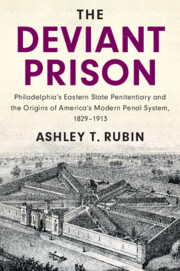 The Deviant Prison
The Deviant Prison Book contents
- Frontmatter
- Contents
- List of Figures
- List of Tables
- Acknowledgements
- List of Abbreviations
- A Brief Timeline
- Important Actors
- Introduction
- Part I Becoming the Deviant Prison: Establishing The Conditions for Personal Institutionalization
- 1 Faith and Failure: Experimenting with Solitary Confinement in America’s Early State Prisons
- 2 Born of Conflict: The Struggle to Authorize the Pennsylvania System
- B The Men in Charge
- 3 Uncertainty and Discretion: The Contours of Control at Eastern State Penitentiary
- 4 Criticism and Doubt: The Pennsylvania System and the Social Construction of Penal Norms
- Part II THE ADVANTAGE OF DIFFERENCE: The Process of Institutionalization
- Part III Forced to Adapt: The Conditions for and Process of Deinstitutionalization
- Appendix A Inspectors
- Index
3 - Uncertainty and Discretion: The Contours of Control at Eastern State Penitentiary
from Part I - Becoming the Deviant Prison: Establishing The Conditions for Personal Institutionalization
Published online by Cambridge University Press: 12 January 2021
- Frontmatter
- Contents
- List of Figures
- List of Tables
- Acknowledgements
- List of Abbreviations
- A Brief Timeline
- Important Actors
- Introduction
- Part I Becoming the Deviant Prison: Establishing The Conditions for Personal Institutionalization
- 1 Faith and Failure: Experimenting with Solitary Confinement in America’s Early State Prisons
- 2 Born of Conflict: The Struggle to Authorize the Pennsylvania System
- B The Men in Charge
- 3 Uncertainty and Discretion: The Contours of Control at Eastern State Penitentiary
- 4 Criticism and Doubt: The Pennsylvania System and the Social Construction of Penal Norms
- Part II THE ADVANTAGE OF DIFFERENCE: The Process of Institutionalization
- Part III Forced to Adapt: The Conditions for and Process of Deinstitutionalization
- Appendix A Inspectors
- Index
Summary
The necessity of defending the Pennsylvania System—an omnipresent reality at Eastern throughout the nineteenth century and a major cause of its personal institutionalization—was present from the beginning. By the late 1820s, several groups of Pennsylvanians would furiously debate what Eastern's regime should look like. This debate would be shaped not only by the legacy of past failures, but also by mounting criticism of pure solitary confinement (continuous solitary without distractions) as well as other developments beyond Pennsylvania. The Pennsylvania System that was ultimately authorized at Eastern resulted from this contentious period. Forged in conflict, it was designed to achieve the original goals of the first prisons, but it was also designed reactively to avoid previous failures at Walnut Street Prison, Auburn State Prison, and Western State Penitentiary. Importantly, that this period would end with Pennsylvania deviating from the rest of the country was far from a foregone conclusion. For a while, it seemed that Pennsylvania might abandon its reformers' preference for continuous solitary confinement and copy New York's new approach to incarceration.
Keywords
- Type
- Chapter
- Information
- The Deviant PrisonPhiladelphia's Eastern State Penitentiary and the Origins of America's Modern Penal System, 1829–1913, pp. 65 - 98Publisher: Cambridge University PressPrint publication year: 2021


